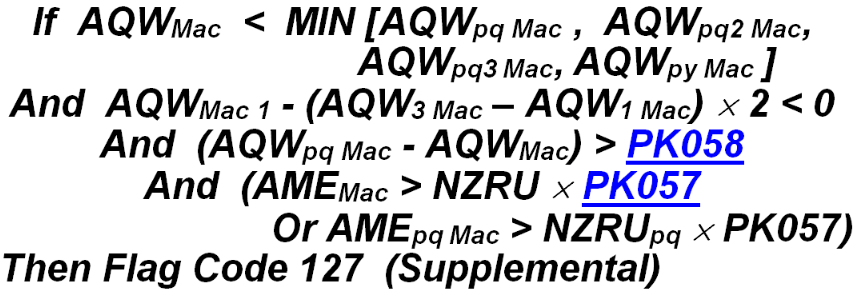11 code 127 average quarterly wage change check macro edit version
Average Quarterly Wage Change Check - Code 127 - Macro Edit Version - Program ES2MA02
Like the micro edit version of Code 127, the macro version has a two-phase primary editing system, with a back-up secondary editing facility. However, there are several differences between the micro and macro application of this edit. One difference is that the wages-without-employment and employment-without-wages edits are not conducted first for the macro edits, as they are for the micro equivalents. Another disparity is that secondary editing does not involve any two-million-dollar difference checks on the macro side. One of the primary differences, however, between editing micro and macro wage data is that the micro edits can be skipped based on either missing indicators or inactive status codes in back quarters. Since the macro data contain no indicators, the only acceptable substitute is the number of reporting units. If there are no micro records included in the macro aggregate for one or more of the past four quarters, this edit is skipped, due to lack of data. Each of the processes will be described in turn.
The first phase of the primary edit checks for the absolute change of AQW between current and prior quarter, is as shown below:
Since the average quarterly wages do not grow larger with increasing unit counts, as would employment or total wages, no scaling is required for the PK019 tolerance. As with previous edit descriptions, the pq subscript refers to prior quarter data (i.e., the quarter immediately preceding the edited quarter). Those macro cells failing to meet the PK019 AQW change requirement will continue with the supplemental AQW edit, having passed the standard edit. Although the supplement was initially developed as a parallel to the micro-edit version, it is greatly simplified. This supplemental edit will be described shortly.
The HIT Test reference identifies the “Hoaglin, Iglewicz, and Tukey test,” the second half of the Code 127 edit. This test also parallels the micro-level edit. When any of the past four quarters has no establishments assigned to the macro cell, the range for HIT testing is set to zero. For the fully-reported macro cells, the four previous quarters of AQW values are sorted from lowest to highest, but only if the current AQW is either larger than, or smaller than, all of the past four AQW values. The reason for this exclusion is that the second lowest and second highest AQW values will be used to establish the inner bounds (i.e., the first and third quartiles) of allowable fluctuation, which will then be extended to produce the outer boundaries. If the edited quarter’s AQW is only the second largest or second smallest of the five-quarter set, it is already in the inner bounds, which makes it a valid value. Such a non-maximum, non-minimum value is also exempt from the Supplemental Edit, which requires the edited quarter’s AQW value to be the lowest of five consecutive values. When the current AQW is neither the largest nor the smallest of these five quarter values, it automatically passes both the standard and the supplemental edit.
For those AQW’s still eligible for the remaining part of the edit, the second smallest and second largest AQW values are selected from the five-quarter set, and are labeled as the AQWMac 1 (macro first quartile) and AQWMac 3 (macro third quartile) fields, respectively. These are used in the “HIT” formulation as shown:
Here, the allowable tolerance is set either to double the first-to-third quartile difference, or to the PK019 inter-quarter AQW change tolerance, whichever is larger. When the current AQW is so far off the mark that it can exceed the next most extreme value by a tremendous margin (double the quartile difference), then it is flagged. That means that a macro cell containing aggregates of some micros with high inter-quarter volatility of wages, paying substantial bonuses, etc., can even allow major AQW changes to pass when this kind of activity has happened before.
For a macro record that fails both levels of the edit, Code 127 is added to the macro edit record. Later, when the micro edits are run, this can be matched to any of the accounts contained in the macro aggregate that have been flagged with an employment or wage-related edit exception. By identifying these micro records and dealing with them, the macro edit exception can be resolved.
The remaining macro cells that have not failed both levels, but have also not been exempted from the rest of the edit by conditions noted earlier, can be subjected to the Secondary Edit. Here a low AQW value in the edited quarter is checked for an exceptional variation from the normal wage values. The example shown earlier would be applicable to the macro-level edit as well. The formulation for the supplemental edit is shown below.
The subscripts pq, pq2, pq3, and py represent successively older back quarters, and the 1 and 3 subscripts denote the first and third quartiles.
Related Links


